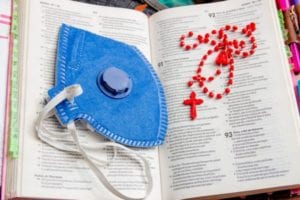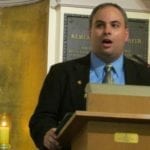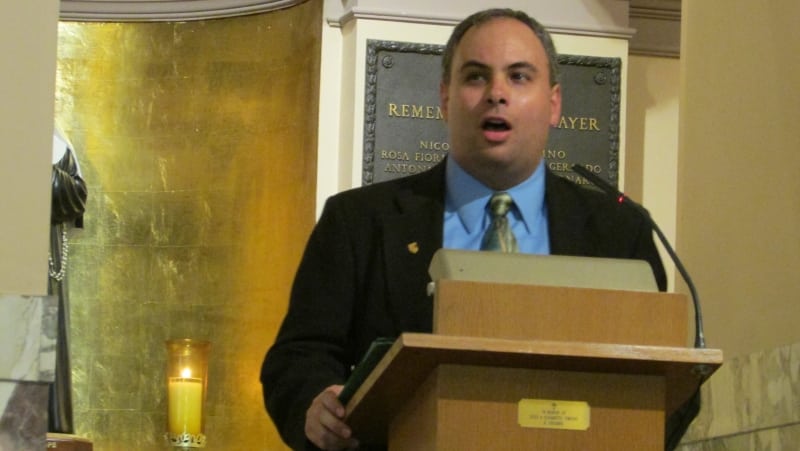By Harry Dudley & Marc DelMonico
When NALM asked us to write an article for the April newsletter back in January, it was originally going to be focused on developments in the field of lay ecclesial ministry during this 15th anniversary year of Co-Workers in the Vineyard of the Lord. That was then – in the “before times,” the so-called “normal” times.
The Covid-19 pandemic has caused widespread death and physical, social, emotional and spiritual suffering on an unimaginable scale. We know full well that our churches have not been spared. Ironically, the siege of this virus has closed our church buildings, broken our hearts as it has separated us physically, and deprived us of the solace and spiritual connection which the institutional sacraments of the Church can provide, especially in times like this. We commemorated Holy Week more like the first disciples than many “Western” Christians have in centuries – behind locked doors in fear and trembling. We continue this Easter Season, amid anxiety and often overwhelming questions, about the future of ministry. In light of the devastating human and financial impacts to our churches and our ministry organizations, we need to spiritually “vaccinate” ourselves against the temptation to believe that in this challenging time that the Easter Jesus is calling us “back to normal.” For the Risen Christ, there is no “back to normal.” There is only the ever new mission to “proclaim the good news to the whole creation.” (Mark 16:15). There is an invitation to a “new normal” that is far better than the old.
Thus, as we reflected on this article, we both knew that it could not be that article we originally envisioned. It isn’t “normal time.” Yet we hope it captures some of the sensibilities that we hoped might be in that initial article as we dig deeply together with so many of you to understand the needs and shape of lay ecclesial ministry for today.
Ministry: Mobilizing the Baptized
At the end of March, Harry saw a picture on Facebook with many moving images of Catholics – including Pope Francis – responding with care for others and the world, and a large caption which read, “The Church is not empty. The Church has been mobilized.”
He shared the image with participants in a course he was teaching – “Vatican II and our call to Holiness” – for his parish in Western, Pennsylvania. The pandemic caused the live session course to have to go digital just as they were covering the Council’s Pastoral Constitution on the Church in the Modern World (Gaudium et Spes). The participants had defined holiness as: “Being set apart, chosen from.” But not in the sense of “above” others, but for others. This definition was discerned based on how often in the Scriptures that people who encountered the Living God found that they were given a mission; they were being sent. So, the search for holiness involves discovering what God is calling us to do for others.
The image challenged those facilitating and taking the course to consider how our parish community, in the midst of this pandemic, was focusing on our call to be of service to our local community. We realized that although we were merging seven communities and parish sites into one parish, that our focus needed to be less on how to maintain ourselves and more on how we could better mobilize all the baptized in our community to focus on our mission to serve during this crisis. It became clear that this pandemic was challenging us all to find new ways of being of service to our larger community.
 Each of our national organizations for lay ecclesial ministers are likewise striving to see how we can better serve our members. The invitations to NALM members to join in conversation with members of the board are a good example.
Each of our national organizations for lay ecclesial ministers are likewise striving to see how we can better serve our members. The invitations to NALM members to join in conversation with members of the board are a good example.
The physical isolation that we are experiencing must not pour over into our ministries. We need one another more than ever to share our gifts and best practices as we discover together new ways to serve one another and our communities.
For too long we have been making excuses for not using social media or being overly cautious about deploying technologies in ministry, but the time is now to find the right ways to use these resources to help us mobilize one another and all the baptized. How have we helped our community leaders to share their gifts?
What are you discovering as your parish community or organization seeks to minister during this time? What technology or techniques are you using to help reach your colleagues and those whom you serve? The USCCB Office of Certification has been collecting resources created to help us during the Covid-19 Pandemic. What strategies have you devised? What resources have you found helpful? Are there skills you learned in ministry formation which are especially helpful now? The NALM Board wants to hear your experiences. Reach out and share them at [email protected].
We are all aware of the ways in which the need for maintenance of our structures and institutions is being sorely tested during this time. Can an emphasis on mobilizing the baptized as a central strategy for our ministry during this pandemic help us build support in financial and other ways as we strive for a “new normal”?
Technical Innovations Require Pastoral Strategies
 Part of striving for the “new normal” involves confronting the challenges presented by physical distancing. While technology has helped close the gap during the pandemic, by itself it is an unstable bridge. It has, of course, helped alleviate ecclesial “isolation.” Online liturgies, prayer services, and online interactive calls with multiple people (Skype, Zoom, etc.) are wonderful gifts during this prolonged time of separation from the sacraments and the gatherings of the Church. Deploying these technologies to connect people was a necessary first step in an emergency situation. Now ministry leaders need to think strategically about what to do with them.
Part of striving for the “new normal” involves confronting the challenges presented by physical distancing. While technology has helped close the gap during the pandemic, by itself it is an unstable bridge. It has, of course, helped alleviate ecclesial “isolation.” Online liturgies, prayer services, and online interactive calls with multiple people (Skype, Zoom, etc.) are wonderful gifts during this prolonged time of separation from the sacraments and the gatherings of the Church. Deploying these technologies to connect people was a necessary first step in an emergency situation. Now ministry leaders need to think strategically about what to do with them.
Some may be tempted to think that putting Mass or religious education “online” in some form is enough to carry the weight of the spiritual need people are experiencing right now. This is not the case. First, not all people have access to the same level of technology or technical capability due to personal choice, financial situation, or geographic location. Many rural areas of our country have no good internet providers! Second, if these wonderful online access opportunities remain one-way communications only (from parish “headquarters” to parishioners’ screens, for example), ministers are missing important opportunities for interaction. They risk fostering an isolated and individualistic spirituality which, when all this is over, will be hard to re-integrate into the communal and physical assembly of the Church’s sacramental life.
So, what are some additional creative steps ministers in leadership can take? Fortunately, one option requires almost no technological expertise whatever. Leadership teams can, together with volunteers, make telephone calls to parishioners or members of their communities. They can use that time to check in on them, find out how they are doing, if their needs are being met, what their concerns or fears are, and to connect them to those in the parish who might respond – either to direct physical needs, counselling, other pastoral care, etc. Indeed, some of those who get a call from the parish might volunteer to make calls themselves! A direct outreach to people in whatever way possible can be a meaningful experience for those who are living by themselves and lonely or who are juggling work and family in the same space and need to know someone understands the difficulties. Tom Quinlan, Director of the St. Joseph Educational Center in Iowa, offered many similar ideas, including a basic set of questions that could be a good phone call script.
Another idea is to consider how to combine the strengths of liturgy and catechetical / faith formation activities when offering online events. Consider how the readings or prayers of the Sunday liturgy might connect with items people may have in their homes or on their property which they can hold or use during the Mass. For example, prior to many online Palm Sunday celebrations, leaders encouraged parishioners to find any branch from a tree near their home and bring it to the online Mass for a blessing. Prior to the Good Friday liturgy, people were invited to bring a cross or crucifix for personal or family veneration. During this Easter Season, the option to replace the Penitential Act with the Rite for the Blessing and Sprinkling of Holy Water each week allows families to bring a bowl of water to the liturgy and have it blessed. Then they may use it (with perhaps a Q-tip to avoid contamination) to bless themselves during the week. For Good Shepherd Sunday (May 3), invite people at home to find something decorated with the image of a sheep, or something made from wool and incorporate meanings into the homily. Encourage parents to talk to their children about what it means to be like a sheep who follows the voice of the Good Shepherd and Jesus’ example of caring for those in need. There are many creative opportunities to help make what could otherwise be one-way communication more interactive on the receiving side!
 There are many other ideas to consider as well. Almost every parish or community will experience the loss of loved ones due to Covid-19 or other illnesses during this time, but may not be able to gather physically for funerals. A Memorial Mass in the distant, unknown future may not be as comforting as a 15-minute adaptation of the Vigil for the Deceased from the Order of Christian Funerals, presuming the person who has died or their survivors would find it meaningful and grant permission. A version of that via Zoom may allow extended family and close friends to have important closure and be reassured that their loved one is lovingly prayed into the arms of God. People who are at home with a lot of free time could create protective masks for other parishioners or community groups who need them. Perhaps the parish can even donate the materials and provide a place to collect them. (People could even include a little slip of paper about who made the masks, so that when someone receives them, they will know cared enough for their safety that they took time to make the mask for them.) And, of course, in this time of separation from the Eucharist and the sacraments, we can encourage those who think they are “doing nothing” at home to become powerhouses of prayer, making use of the many sacramentals which are part of our personal prayers and customs (Rosaries, Divine Mercy chaplet, Prayers to the Infant of Prague, etc.) or prayer resources from the parish or other Catholic websites. Finally, looking at how small virtual groups might come together to pray the Liturgy of the Hours, do Scripture sharing on the Sunday readings, or simply to socialize would help diminish the negative effects of isolation.
There are many other ideas to consider as well. Almost every parish or community will experience the loss of loved ones due to Covid-19 or other illnesses during this time, but may not be able to gather physically for funerals. A Memorial Mass in the distant, unknown future may not be as comforting as a 15-minute adaptation of the Vigil for the Deceased from the Order of Christian Funerals, presuming the person who has died or their survivors would find it meaningful and grant permission. A version of that via Zoom may allow extended family and close friends to have important closure and be reassured that their loved one is lovingly prayed into the arms of God. People who are at home with a lot of free time could create protective masks for other parishioners or community groups who need them. Perhaps the parish can even donate the materials and provide a place to collect them. (People could even include a little slip of paper about who made the masks, so that when someone receives them, they will know cared enough for their safety that they took time to make the mask for them.) And, of course, in this time of separation from the Eucharist and the sacraments, we can encourage those who think they are “doing nothing” at home to become powerhouses of prayer, making use of the many sacramentals which are part of our personal prayers and customs (Rosaries, Divine Mercy chaplet, Prayers to the Infant of Prague, etc.) or prayer resources from the parish or other Catholic websites. Finally, looking at how small virtual groups might come together to pray the Liturgy of the Hours, do Scripture sharing on the Sunday readings, or simply to socialize would help diminish the negative effects of isolation.
Up until now, our article has not mentioned the one thing that is almost certainly the highest anxiety in the minds of clergy, lay ministers and other church leaders: budget and finances. Again, Tom Quinlan’s recommendations are valuable here. Making sure people support the parish or community financially is essential, but during this time it shouldn’t be the initial request. Even though we all know how dire the realities are, we should do what is possible to contextualize the financial “ask” within the pastoral “task.” We should help people see more clearly how a financial gift at this time (which for many will be a big hardship!) will directly help provide the spiritual care and services that are helping them, their fellow parishioners and the wider community. The pandemic is ironically giving us a chance to put into practice the good stewardship, leadership and transparency concerning parish finances that we always should have had in place! Consider how you can be as specific as possible.
Last but not least, we only had a limited space to share ideas with you about how lay ministers and other leaders can adapt to new pathways of ministry during this extraordinarily difficult and painful time for our church, country and world. You may have others. We hope you will consider sharing them at [email protected] so that all of us will benefit from your experiences (including what worked well and what didn’t work well!). Though separated now, we can together be resources for one another and models of “mobilized” ministry in the Spirit of the Risen Christ as we entrust our work to him in forging the “new normal” to which our Easter mission invites us.
This article first appeared in the “News and Notes” May 2020 newsletter of the National Association for Lay Ministry (NALM), and has been reprinted here with the permission of all parties.
* * *
 Harry J. Dudley, D.Min. is a member of NALM’s Advocacy Committee and the both the Leadership team and Formation committee of the Catholic Prison Ministries Coalition (www.catholicprisonministries.org.) In 2019, he received the NACC (www.nacc.org) Outstanding Colleague Award for his support of and contribution to advancing the profession of spiritual and pastoral care. Upon retiring from the USCCB in 2018, he and his wife, Patricia, inspired by Pope Francis’ call for all Catholics to “accompaniment”, created Ambulans Vobiscum Consulting to focus on helping non-profits and churches develop curriculum, leaders and formation for service. He can be reached at [email protected]
Harry J. Dudley, D.Min. is a member of NALM’s Advocacy Committee and the both the Leadership team and Formation committee of the Catholic Prison Ministries Coalition (www.catholicprisonministries.org.) In 2019, he received the NACC (www.nacc.org) Outstanding Colleague Award for his support of and contribution to advancing the profession of spiritual and pastoral care. Upon retiring from the USCCB in 2018, he and his wife, Patricia, inspired by Pope Francis’ call for all Catholics to “accompaniment”, created Ambulans Vobiscum Consulting to focus on helping non-profits and churches develop curriculum, leaders and formation for service. He can be reached at [email protected]
 Marc DelMonico, Ph.D., is the Director of the Office of Certification for Ecclesial Ministry and Service at the United States Conference of Catholic Bishops, where he collaborates with and resources a subcommittee of the bishops’ conference, dioceses, and national organizations seeking to develop and enhance promotion, recruitment, formation, certification and recognition of lay ecclesial ministers (https://usccb.org/certification). Marc is a professional theologian and ministry & communications consultant for Catholic and Christian parishes, communities and organizations. You can read more about him and his most recent work gathering resources for ministry in the wake of Covid-19, at his professional website: https://churchmd.com
Marc DelMonico, Ph.D., is the Director of the Office of Certification for Ecclesial Ministry and Service at the United States Conference of Catholic Bishops, where he collaborates with and resources a subcommittee of the bishops’ conference, dioceses, and national organizations seeking to develop and enhance promotion, recruitment, formation, certification and recognition of lay ecclesial ministers (https://usccb.org/certification). Marc is a professional theologian and ministry & communications consultant for Catholic and Christian parishes, communities and organizations. You can read more about him and his most recent work gathering resources for ministry in the wake of Covid-19, at his professional website: https://churchmd.com



 Request Dr. DelMonico's professional services for a liturgical, ministerial or leadership consultation, or for an academic or public presentation.
Request Dr. DelMonico's professional services for a liturgical, ministerial or leadership consultation, or for an academic or public presentation.